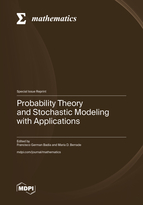Probability Theory and Stochastic Modeling with Applications
A special issue of Mathematics (ISSN 2227-7390). This special issue belongs to the section "Probability and Statistics".
Deadline for manuscript submissions: closed (15 March 2023) | Viewed by 22705
Special Issue Editors
Interests: reliability analysis; stochastic orders; multivariate dependency; univariate counting processes; multivariate counting processes; probabilistic methods in approximation theory
Special Issue Information
Dear Colleagues,
We are pleased to inform you about a forthcoming Special Issue in the journal Mathematics with the topic “Probability Theory and Stochastic Modeling with Applications”. This subject matter aims at highlighting the crucial role of probability and stochastic processes to solve problems that affect our society. Potential applications may be concerned with but are not limited to technology, energy, industry, environment, sustainability, or climatic change.
This Special Issue will include both papers developing new methodologies as well as those using known procedures for working out actual problems. In addition to original research, review articles are also welcome.
With this Special Issue, Mathematics also wants to promote a new generation of researchers on probability and stochastic processes, attracting students’ interest to this field.
We believe that your contributions will be highly valuable to make this Special Issue a great success. We look forward to your contributions!
Prof. Dr. Francisco German Badía
Prof. Dr. María D. Berrade
Guest Editors
Manuscript Submission Information
Manuscripts should be submitted online at www.mdpi.com by registering and logging in to this website. Once you are registered, click here to go to the submission form. Manuscripts can be submitted until the deadline. All submissions that pass pre-check are peer-reviewed. Accepted papers will be published continuously in the journal (as soon as accepted) and will be listed together on the special issue website. Research articles, review articles as well as short communications are invited. For planned papers, a title and short abstract (about 100 words) can be sent to the Editorial Office for announcement on this website.
Submitted manuscripts should not have been published previously, nor be under consideration for publication elsewhere (except conference proceedings papers). All manuscripts are thoroughly refereed through a single-blind peer-review process. A guide for authors and other relevant information for submission of manuscripts is available on the Instructions for Authors page. Mathematics is an international peer-reviewed open access semimonthly journal published by MDPI.
Please visit the Instructions for Authors page before submitting a manuscript. The Article Processing Charge (APC) for publication in this open access journal is 2600 CHF (Swiss Francs). Submitted papers should be well formatted and use good English. Authors may use MDPI's English editing service prior to publication or during author revisions.
Keywords
- Probability and statistics
- Advanced probabilistic methods
- Probabilistic learning
- Probabilistic optimiaztion
- Stochastic processes and analysis
- Gaussian processes
- Markov processes
- Random fields
- Statistics for stochastic processes
- Stochastic analysis
- Stochastic optimization
- Stochastic control
- Probability and stochastic methods in technology, industry, and environment







